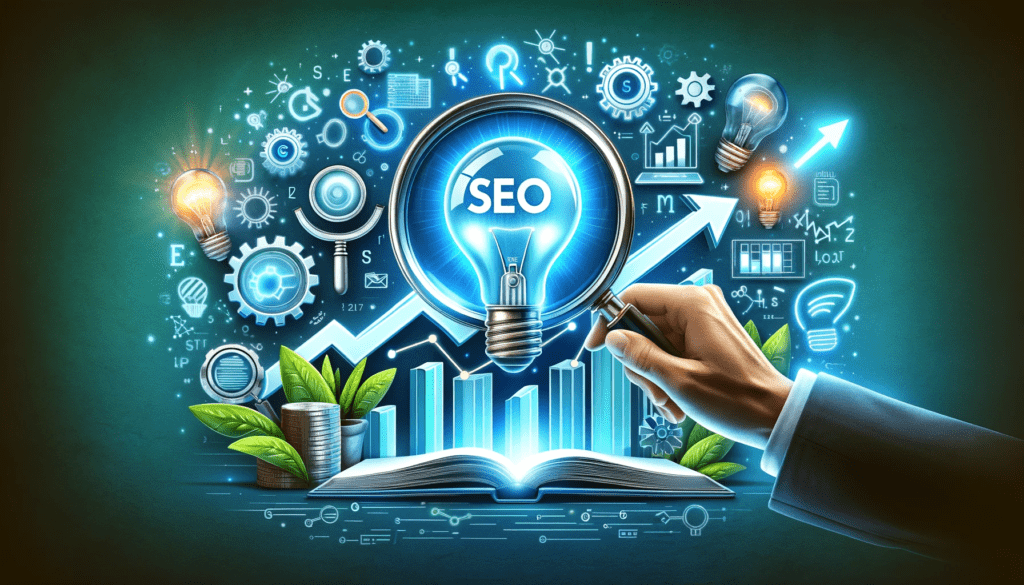
- I. Navigating the B2B SaaS Landscape
- II. Crafting a Robust Lead Generation Strategy
- III. Leveraging Content Marketing for Lead Generation
- IV. Maximizing SEO for Lead Generation
- V. Utilizing Email Marketing and Newsletters
- VI. Harnessing the Potential of Social Media Platforms
- VII. Paid Advertising and Its Role in Lead Generation
- VIII. Webinars and Educational Events as Lead Magnets
- IX. Building Trust through Testimonials and Case Studies
- X. Conversion Optimization and CRM Integration
- XI. Measuring Success and Refining Strategies
- XII. The Continuous Evolution of B2B Lead Generation
I. Navigating the B2B SaaS Landscape

The B2B SaaS market is a dynamic and competitive space where successful lead generation is both an art and a science. In this rapidly evolving industry, companies must navigate unique challenges and continuously adapt to remain ahead.
Understanding the Unique Challenges of B2B SaaS Lead Generation
In the B2B SaaS sector, lead generation is not just about reaching a broad audience but about connecting with the right customers. These are typically businesses seeking solutions to specific problems or ways to enhance their operations.
The SaaS model, with its emphasis on software as a service, necessitates a deep understanding of customers’ ongoing needs and the ability to offer effective, scalable solutions.
Unlike traditional product-based businesses, SaaS companies face the challenge of selling an intangible product. This means they must not only convince potential customers of the software’s value but also establish trust and credibility.
The SaaS environment is also characterized by rapid changes in technology and customer expectations, making agility and responsiveness key factors for success.
The Importance of Adapting to the Current Market Environment
Adapting to the current market environment is crucial for B2B SaaS companies. This involves staying abreast of industry trends, understanding the evolving needs of businesses, and leveraging the latest marketing strategies to reach and engage potential customers effectively.
The digital nature of the SaaS market offers numerous channels and tactics for lead generation, from SEO and content marketing to email campaigns and social media strategies.
However, with so many options available, it’s important for businesses to choose the right mix of tactics that align with their target audience and business goals.
In this article, we will explore the various strategies and tools that can be employed in the art of B2B lead generation for today’s SaaS market.
From crafting a robust lead generation strategy to leveraging advanced marketing tactics, this guide aims to provide valuable insights for SaaS companies looking to enhance their lead generation efforts and drive business growth.
II. Crafting a Robust Lead Generation Strategy

In the competitive SaaS market, a well-crafted B2B lead generation strategy is essential for success. This section delves into the key components of an effective strategy and how they align with business goals.
Identifying Key Components of an Effective B2B Lead Strategy
A robust lead generation strategy in the B2B SaaS space hinges on several critical components. Firstly, identifying the target audience is paramount. This involves understanding the specific needs, challenges, and behaviors of potential B2B customers.
For a SaaS company, this could mean focusing on businesses that are likely to benefit most from the software, considering factors like company size, industry, and technological readiness.
Once the target audience is defined, the next step is to develop a value proposition that resonates with this group. This proposition should clearly articulate how the SaaS product addresses specific business problems or improves operations. It’s also crucial to choose the right channels for reaching this audience.
While LinkedIn might be ideal for connecting with business professionals, other platforms like industry-specific forums or B2B marketplaces like Capterra might also be relevant.
Content strategy plays a vital role in lead generation. Producing high-quality, informative content that addresses the pain points and interests of the target audience can attract and engage potential leads. This could include blogs, whitepapers, ebooks, and case studies.
Aligning Business Goals with Lead Generation Efforts
Aligning lead generation efforts with broader business goals is crucial for long-term success. For SaaS companies, this could mean focusing on leads that have the potential for high customer lifetime value or targeting industries where the product has a strong competitive advantage.
It’s also important to set specific, measurable goals for lead generation campaigns. These goals might include the number of leads generated, the conversion rate of leads to paying customers, or the cost per lead.
By setting these goals, companies can better measure the effectiveness of their strategies and make data-driven adjustments as needed.
Effective lead generation in the B2B SaaS market also involves a multi-faceted approach, integrating various tactics like SEO, email marketing, social media outreach, and paid advertising.
Each of these tactics should be tailored to the specific characteristics and preferences of the target audience.
Crafting a robust B2B lead generation strategy for the SaaS market requires a deep understanding of the target audience, a compelling value proposition, strategic use of content, and alignment with overarching business goals.
By focusing on these key areas, SaaS companies can build a strong foundation for generating high-quality leads and driving business growth.
III. Leveraging Content Marketing for Lead Generation

Content marketing stands as a cornerstone in the B2B SaaS lead generation strategy, harnessing the power of educational and engaging content to attract and convert prospects.
The Power of Educational and Engaging Content
In the B2B SaaS industry, where products are often complex and solutions are nuanced, content marketing is vital for educating potential customers. High-quality content helps in demystifying product features and demonstrating the real-world value of the SaaS platform.
This educational approach is crucial in a market where customers are often looking for solutions to specific problems or ways to optimize their existing processes. Educational content also positions a company as a thought leader in its field, building trust and credibility with its audience.
This trust is particularly important in the SaaS industry, where businesses are not just purchasing a product, but investing in a long-term service solution.
Content Types That Resonate with B2B SaaS Audiences
When it comes to the types of content that resonate with B2B SaaS audiences, diversity and relevance are key. Blog posts that tackle common industry challenges, offer solutions, or provide insights into emerging trends can attract a wide range of B2B customers.
These can be supplemented with in-depth whitepapers or ebooks that delve deeper into specific topics, providing more detailed information and showcasing the company’s expertise.
Case studies and testimonials are another powerful form of content, offering proof of the software’s effectiveness and value. By highlighting real-world examples of how the product has helped other businesses, potential customers can better understand and relate to the benefits.
Webinars and video content have also emerged as effective tools in content marketing. They provide an interactive platform for demonstrating the product, sharing expertise, and engaging with potential leads in real-time.
Interactive tools like calculators, quizzes, or interactive demos can further engage potential clients, providing them with valuable insights while simultaneously capturing lead information.
Leveraging content marketing in B2B SaaS lead generation involves creating a range of educational and engaging content that addresses the specific needs and interests of the target audience.
By providing valuable information and demonstrating expertise, businesses can attract potential leads, build trust, and guide prospects through the buyer’s journey, ultimately leading to conversions.
IV. Maximizing SEO for Lead Generation

For B2B SaaS companies, SEO is a critical tool in driving targeted traffic and generating leads. By optimizing for search engines, these companies can attract potential customers actively seeking solutions.
Utilizing SEO Best Practices to Boost B2B Traffic
SEO for B2B SaaS involves a range of best practices designed to enhance the visibility of a company’s website in search engine results. This begins with understanding the search behaviors of the target audience.
What problems are they trying to solve? What type of SaaS solutions are they searching for? Answering these questions helps in identifying the right keywords and topics for content creation.
Technical SEO is also crucial. Ensuring that the website is fast, mobile-friendly, and easy to navigate helps in retaining the attention of potential leads.
Additionally, on-page optimization like using the right keywords in titles, meta descriptions, and headers is essential for search engines to understand and rank the content effectively.
Keyword Strategies to Attract Ideal SaaS Customers
Choosing the right keywords is at the heart of a successful SEO strategy. For B2B SaaS companies, this means focusing on keywords that reflect the specific features and benefits of their software, industry-specific terms, and the pain points of their target customers.
Long-tail keywords, which are more specific and often less competitive, can be particularly effective for B2B SaaS. They align closely with the specific queries of potential customers, increasing the chances of attracting high-quality leads.
For example, instead of a broad keyword like “project management software,” a more targeted long-tail keyword could be “project management software for remote teams.”
Integrating these keywords naturally into high-quality, informative content is key. This approach not only improves SEO rankings but also provides value to potential customers, establishing the company’s credibility and expertise in the field.
By effectively utilizing SEO best practices and strategically selecting keywords, B2B SaaS companies can significantly enhance their online visibility. This not only drives more traffic to their website but also ensures that the traffic is highly relevant, increasing the likelihood of converting visitors into leads.
With the right SEO approach, these companies can effectively connect with their target audience, providing solutions that meet their specific business needs.
V. Utilizing Email Marketing and Newsletters

Email marketing and newsletters are vital tools in the B2B SaaS lead generation toolkit, offering a direct line of communication to potential clients.
Building a Targeted Email List for SaaS Prospects
The first step in effective email marketing is building a targeted list of prospects. This involves collecting emails from various sources, such as website sign-ups, webinar registrations, and downloadable content offers.
Ensuring that these prospects have opted in is crucial for compliance and for maintaining the integrity of the campaign.
Segmentation of the email list is another critical strategy. It allows for tailoring content and offers to specific groups within the audience, based on factors like industry, company size, or stage in the buying journey.
This targeted approach increases the relevance of the emails, thereby enhancing engagement rates.
Creating Engaging and Personalized Email Campaigns
Once a targeted list is established, the focus shifts to creating engaging and personalized email content. This content should provide value to the recipient, whether through insightful industry analysis, helpful tips, or updates about the SaaS product.
For example, an email campaign for a project management tool might include tips for improving team productivity, which is both relevant and valuable to the target audience.
Personalization extends beyond just addressing the recipient by name. It involves tailoring the content to their specific needs and interests, based on the data collected. This could include personalized product recommendations, content tailored to their business challenges, or updates relevant to their industry.
Automated email workflows can be used to nurture leads effectively. These workflows trigger specific emails based on actions that the recipient has taken, such as downloading a piece of content or attending a webinar. This ensures that the potential customers receive timely and relevant follow-ups, moving them closer to a decision.
Emails and newsletters should also include clear calls-to-action (CTAs), guiding the recipients toward the next step, whether it’s scheduling a demo, signing up for a free trial, or reading a blog post.
By carefully building and segmenting email lists, creating personalized and engaging content, and using automated workflows, B2B SaaS companies can turn email marketing into a powerful tool for lead generation.
This approach not only helps in attracting potential leads but also plays a crucial role in nurturing these leads through the sales funnel.
VI. Harnessing the Potential of Social Media Platforms

Social media platforms are increasingly becoming a pivotal element in B2B SaaS lead generation strategies. They offer unique ways to connect, engage, and convert potential leads into customers.
Leveraging LinkedIn for B2B Connections and Leads
LinkedIn stands out as a prime platform for B2B lead generation in the SaaS industry. With its professional user base, LinkedIn allows SaaS companies to target decision-makers and influencers within their target industries.
Utilizing LinkedIn for sharing content, joining industry groups, and engaging in professional discussions can significantly boost a company’s visibility and credibility.
Creating detailed company pages, posting regular updates about products, services, and industry insights, and actively participating in relevant LinkedIn groups are effective ways to attract and engage potential leads.
LinkedIn’s advanced targeting capabilities in its advertising platform also enable SaaS companies to run highly targeted ad campaigns, reaching the exact audience that would benefit from their solutions.
Engaging Prospects on Platforms like X, formerly Twitter, and Facebook
While LinkedIn is pivotal for professional networking, other platforms like Twitter and Facebook also hold considerable potential for lead generation.
X, formerly Twitter, can be used for real-time engagement, sharing quick updates, industry news, and participating in relevant conversations through hashtags. It’s a platform where companies can showcase their brand personality and thought leadership.
Facebook, with its vast user base, can be a valuable tool for building brand awareness and community engagement. Through targeted Facebook ads, engaging posts, and active community management, SaaS companies can create a loyal following, leading to increased lead generation opportunities.
Utilizing social media listening tools can also be beneficial. These tools help companies monitor conversations about their brand, competitors, and industry, providing valuable insights that can guide content creation and outreach strategies.
Social media platforms, when used effectively, can be powerful tools in a SaaS company’s lead generation arsenal. They offer unique ways to connect with potential customers, showcase expertise, and build relationships that can eventually turn into successful business partnerships.
By strategically leveraging these platforms, B2B SaaS companies can enhance their lead generation efforts and foster meaningful connections with their target audience.
VII. Paid Advertising and Its Role in Lead Generation

Paid advertising is a pivotal component in the B2B lead generation arsenal, especially for SaaS companies looking to break through the noise and reach their target audience efficiently.
Strategizing PPC Campaigns for Maximum ROI
Pay-Per-Click (PPC) campaigns are a mainstay in online advertising due to their ability to target specific audiences with precision. For B2B SaaS companies, the focus should be on creating PPC campaigns that resonate with the needs and interests of their ideal customers.
This involves thorough market research to understand the keywords and phrases that potential clients use when searching for SaaS solutions.
Platforms like Google Ads offer a range of targeting options, from keyword-based searches to audience demographics and interests.
The key is to align the PPC strategy with the customer’s journey, ensuring that ads appear at the right time and in the right context to generate maximum engagement.
Utilizing Google Ads and Other Platforms for Targeted Reach
Google Ads is a powerful tool for B2B SaaS businesses, offering extensive reach and detailed analytics to track campaign performance. However, diversifying ad spend across different platforms can further enhance lead generation efforts.
For example, LinkedIn Ads can be particularly effective for B2B targeting, given its professional user base and advanced targeting options that include job titles, industries, and company sizes.
Retargeting campaigns are another crucial aspect of paid advertising. They allow SaaS companies to stay top of mind with prospects who have already shown interest in their product but haven’t converted yet. By displaying ads across different online platforms to these potential customers, companies can nurture leads subtly and effectively.
In addition, exploring options like sponsored content or promoted posts on platforms where potential customers spend time can be beneficial. This approach ensures a more integrated and less intrusive advertising experience, which can be particularly effective in the B2B space.
Crafting successful paid advertising campaigns requires a blend of creativity, data-driven decision-making, and continuous optimization. By closely monitoring campaign performance and making adjustments based on real-time data, SaaS companies can ensure their advertising budget is being used effectively to generate high-quality leads.
Paid advertising, when strategically executed, can significantly boost a SaaS company’s lead generation efforts. It provides a direct and controlled way to reach potential customers, making it an indispensable part of a comprehensive B2B lead generation strategy.
VIII. Webinars and Educational Events as Lead Magnets

Webinars and educational events have become essential tools in the B2B SaaS lead generation playbook, serving as powerful magnets to attract and educate potential clients.
Organizing Impactful Webinars to Attract and Educate Prospects
Webinars provide an interactive platform for SaaS companies to demonstrate their expertise and the value of their solutions. By addressing relevant industry topics, showcasing product features, or exploring case studies, webinars can engage a targeted audience effectively.
The key to successful webinars lies in understanding the interests and pain points of the target audience, ensuring the content is not only informative but also addresses their specific needs.
When organizing webinars, it’s crucial to focus on topics that resonate with potential clients. For instance, a webinar on ‘How to Enhance Team Collaboration Remotely Using [SaaS Product]’ directly appeals to businesses looking for remote work solutions.
Promoting webinars through various channels like email marketing, social media, and partner networks can increase attendance and lead generation opportunities.
Leveraging Events to Showcase Expertise and Solutions
In addition to webinars, participating in or hosting educational events such as workshops, conferences, and seminars can significantly boost a SaaS company’s lead generation efforts. These events provide an opportunity to interact with potential clients face-to-face, building stronger relationships and credibility.
During these events, companies can showcase their products through live demonstrations, offer exclusive trials, or provide in-depth consultations. This direct engagement helps in understanding the audience’s needs better and tailoring the product presentation accordingly.
Networking at these events is equally important. Establishing connections with industry leaders, potential clients, and even competitors can open up new opportunities for collaboration and lead generation.
Additionally, collecting feedback during these events can provide valuable insights into market needs and perceptions, aiding in product development and marketing strategy refinement.
Educational events and webinars serve as effective platforms for demonstrating a SaaS company’s value proposition and industry expertise.
By engaging with potential customers in these settings, companies can not only generate leads but also build long-term relationships that foster trust and credibility in their brand and solutions.
This approach helps in establishing the company as a thought leader in its domain, further enhancing its lead generation capability.
IX. Building Trust through Testimonials and Case Studies

In the realm of B2B SaaS lead generation, establishing trust is a critical component. Testimonials and case studies play a significant role in building this trust by providing social proof and demonstrating the real-world impact of a product or service.
The Impact of Social Proof on B2B Decision-Making
Social proof is a powerful psychological phenomenon where people conform to the actions of others under the assumption that those actions are reflective of the correct behavior.
In the context of B2B SaaS, testimonials and case studies serve as social proof, reassuring potential customers that others have successfully implemented the solution and achieved positive results.
Displaying testimonials from well-known companies or industry leaders can significantly boost a brand’s credibility. Prospects are more likely to trust a SaaS provider when they see that reputable businesses have benefitted from the product.
These testimonials should be prominently featured on the website, in marketing materials, and during sales presentations to maximize their impact.
Using Customer Success Stories to Demonstrate Value
Case studies take the concept of testimonials a step further by providing a detailed account of how a particular customer achieved success with the SaaS product.
These stories should be carefully crafted to highlight the challenges faced by the customer, the solutions provided by the SaaS product, and the tangible benefits realized as a result.
Effective case studies often include specific data and metrics to quantify the success, such as increased revenue, time savings, improved efficiency, or enhanced customer satisfaction. This tangible evidence not only illustrates the value of the product but also helps potential customers visualize what they could achieve.
For maximum effectiveness, SaaS companies should create a range of case studies catering to different industries or use cases. This diversity ensures that prospects from various sectors can find a success story that resonates with their specific situation.
Incorporating testimonials and case studies into a lead generation strategy is more than just displaying positive feedback; it’s about building a narrative of trust and success.
By showcasing real-world applications and results, B2B SaaS companies can break down barriers of skepticism and foster a sense of confidence in their prospects, paving the way for more meaningful engagements and conversions.
X. Conversion Optimization and CRM Integration

Conversion optimization and Customer Relationship Management (CRM) integration are crucial in closing the loop of the B2B lead generation process, ensuring that the leads generated are effectively converted into customers.
Enhancing Website Conversions with Optimized CTAs
For SaaS companies, the website is often the first point of interaction with potential customers. Optimizing this platform for conversions is essential. This involves strategically placing clear and compelling calls-to-action (CTAs) throughout the site.
These CTAs should guide visitors towards taking the next step, whether it’s signing up for a free trial, scheduling a demo, or downloading a whitepaper.
The design and copy of CTAs play a significant role in their effectiveness. They should stand out visually and convey a value proposition that resonates with the target audience. A/B testing different versions of CTAs can help in identifying the most effective ones in terms of language, color, size, and placement.
Leveraging CRM Tools for Effective Lead Management
Integrating CRM tools into the lead generation strategy is vital for tracking and managing leads throughout the sales funnel. A robust CRM system can help SaaS businesses categorize leads based on their engagement level, track their interactions with the website and marketing materials, and provide personalized follow-ups.
CRM integration also enables the sales team to have a comprehensive view of each lead’s journey and preferences, allowing for more tailored and effective sales pitches. This personalized approach can significantly increase the chances of conversion.
Furthermore, CRM tools can automate certain aspects of lead management, such as lead scoring and segmentation, freeing up time for the sales team to focus on high-potential leads.
XI. Measuring Success and Refining Strategies

For B2B SaaS companies, the measurement of lead generation success and the continuous refinement of strategies are critical for achieving sustained growth and staying ahead in a competitive market.
Tracking Key Metrics for B2B Lead Generation Success
To measure the effectiveness of lead generation efforts, it’s essential to track key performance indicators (KPIs). These metrics provide insights into what’s working and what’s not, allowing for data-driven decision-making.
Crucial metrics include lead conversion rates, cost per lead, return on investment (ROI), customer acquisition cost (CAC), and customer lifetime value (CLTV).
For instance, tracking the conversion rate of leads to paying customers can help gauge the effectiveness of different lead generation channels and tactics. Similarly, understanding the CAC is vital in determining the sustainability of the lead generation strategies being employed.
Adapting and Refining Strategies Based on Data and Feedback
The digital landscape, particularly in the B2B SaaS sector, is constantly evolving. As such, it’s crucial for businesses to be agile and adapt their strategies based on ongoing data analysis and market feedback.
This might involve shifting focus to more productive lead sources, tweaking messaging in marketing campaigns, or even reevaluating the target customer profile.
For example, if data shows that certain types of content or specific SEO keywords are driving higher quality leads, a company might decide to allocate more resources towards these areas.
Alternatively, feedback from sales interactions might reveal that clients are seeking additional features or different pricing models, prompting a reevaluation of the product offering or marketing approach.
Regularly reviewing and analyzing campaign analytics, sales data, and customer feedback is vital. This continuous loop of measurement, analysis, and adaptation helps ensure that lead generation strategies remain effective and aligned with market dynamics and business objectives.
In this ever-changing environment, the ability to quickly pivot and refine strategies based on solid data and insights is a key differentiator for successful B2B SaaS companies.
By staying committed to this iterative process of improvement, businesses can not only enhance their lead generation efforts but also build a strong foundation for long-term growth and competitiveness in the market.
XII. The Continuous Evolution of B2B Lead Generation

The landscape of B2B lead generation, particularly in the SaaS market, is one of constant evolution and adaptation. In this dynamic environment, staying ahead demands a commitment to innovation and a deep understanding of the ever-changing needs and behaviors of the target audience.
The Importance of Staying Ahead in the SaaS Market
In the competitive world of SaaS, staying ahead means more than just keeping pace with technological advancements; it involves a proactive approach to understanding market trends and customer expectations.
The companies that thrive are those that anticipate changes in the market and adapt their lead generation strategies accordingly. This could involve embracing new digital marketing techniques, exploring emerging social media platforms, or leveraging data analytics for more targeted marketing efforts.
Embracing Change and Innovation in Lead Generation Tactics
Embracing change is not just a necessity but an opportunity for growth and innovation in lead generation strategies. The most successful B2B SaaS companies are those that view changes in the market as chances to innovate and refine their approach to lead generation.
This might mean adopting new technologies like AI and machine learning for predictive analytics, exploring new content formats, or experimenting with novel marketing channels.
The integration of SEO and content marketing remains a cornerstone strategy in this dynamic landscape. By consistently producing high-quality, relevant content and optimizing for search engines, SaaS companies can attract high-quality leads.
This strategy not only drives traffic but also establishes the company’s authority and expertise in its field, building trust with potential customers.
In summary, the art of B2B lead generation in today’s SaaS market environment is a continuous journey of learning, adapting, and innovating. Companies that are willing to embrace new ideas, experiment with different tactics, and listen to the evolving needs of their audience will be well-positioned to succeed in this ever-changing landscape.
Harness the Power of SEO and Content Marketing

To remain competitive in the ever-evolving B2B SaaS market, it’s crucial to harness the power of SEO and content marketing in your lead generation strategy. These tools are not just about attracting traffic; they’re about attracting the right traffic – high-quality leads that are more likely to convert into loyal customers.
Revitalize your B2B lead generation strategy by focusing on creating engaging, informative content and optimizing your online presence for search engines. This approach will not only increase your visibility but also establish your brand as a trustworthy authority in your field.
Take the first step towards transforming your lead generation efforts. Contact our team of SaaS marketing experts for a consultation. Let us help you craft a strategy that leverages the effectiveness of SEO and content marketing, driving high-quality leads and contributing to the growth and success of your business.